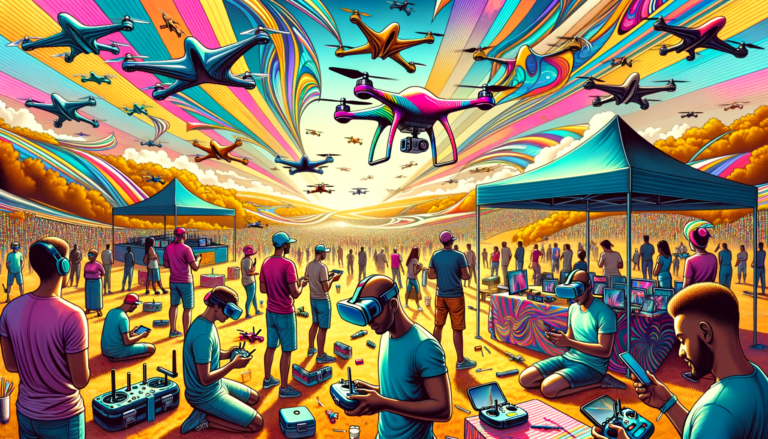Imagine the buzz of propellers, the thrill of high-speed turns, and the excitement of neck-and-neck finishes – welcome to the electrifying world of drone racing! But wait, what’s a “quad” or a “PID controller”? Don’t worry, we’ve got you covered! As drone racing continues to soar in popularity (with a projected market growth of 20.8% from 2023 to 2030), it’s crucial to understand the lingo. Let’s demystify the jargon and get you race-ready with our beginner’s guide to drone racing terminology!
The Basics: What is a Racing Drone?
So, you’ve heard about racing drones and you’re wondering what all the fuss is about? Let’s break it down for you. Racing drones, also known as FPV (First Person View) racing drones, are like the Formula 1 cars of the sky. They’re built for speed, agility, and precision.
Unlike your typical camera drone that you might use for aerial photography, racing drones are designed with one purpose in mind: to go fast and navigate tight courses. These bad boys are equipped with a camera that transmits live video feed to the pilot’s goggles, giving them a bird’s eye view of the action.
The key components of a racing drone include a lightweight frame, powerful motors, propellers, a flight controller, and an FPV system. It’s like a high-tech puzzle where each piece plays a crucial role in performance.
Drone Anatomy 101
Now, let’s dive into the nitty-gritty of what makes these speed demons tick. First up, we’ve got the frame. Think of it as the skeleton of your drone. They come in different shapes and sizes, but most racers prefer carbon fiber frames for their strength and lightweight properties.
Next, we’ve got the motors and propellers. These are the muscles of your drone, providing the thrust to zip through the air. The motors spin the propellers, and together they determine how fast and agile your drone can be.
The brain of the operation is the flight controller. It’s like the central nervous system, processing all the inputs from the pilot and translating them into actions for the motors.
Last but not least, we have the ESCs or Electronic Speed Controllers. These little gadgets act as the middlemen between the flight controller and the motors, ensuring smooth and precise control.
FPV System Terminology
Alright, let’s talk about what makes FPV racing so immersive. The FPV system is what gives pilots that first-person view, making them feel like they’re right in the cockpit.
The star of the show is the camera and video transmitter combo. The camera captures the drone’s point of view, and the video transmitter beams that footage back to the pilot on the ground.
On the receiving end, we’ve got the goggles. These aren’t your average VR headsets – they’re specifically designed for low-latency video transmission, crucial for split-second decision-making in races.
And let’s not forget about antennas. They might look like simple sticks, but they play a huge role in maintaining a clear video signal. The right antenna can mean the difference between a smooth flight and losing connection mid-race.
Racing Classes and Categories
Just like in car racing, drone racing has different classes and categories. You’ve got your micro drones, which are tiny but pack a punch. Then there are mini drones, the most popular size for racing. And for those who want to go all out, there are full-size racing drones.
When it comes to racing formats, you’ll hear terms like “Spec racing” where everyone flies identical drones, or “Open class” where pilots can customize their builds to the max.
And here’s a fun fact: not all FPV flying is about racing. There’s also freestyle, where pilots perform acrobatic tricks and maneuvers. It’s like the skateboarding of the drone world – all about style and creativity.
Flight Modes and Control Systems
Now, let’s get into the nitty-gritty of how these drones are controlled. The most common flight mode for racing is called “Acro” or acrobatic mode. It gives the pilot full control over the drone’s orientation and movement. It’s not for the faint of heart, but it allows for the most precise and aggressive flying.
For beginners, there’s also self-level mode, which helps keep the drone stable and is great for learning the ropes.
Behind the scenes, there’s something called a PID controller. Don’t worry if it sounds complicated – it’s just a system that helps keep the drone stable and responsive to your inputs.
And if you really want to geek out, you can dive into firmware like Betaflight. It’s like the operating system for your drone, allowing you to fine-tune every aspect of its performance.
Racing Lingo and Maneuvers
Every sport has its own lingo, and drone racing is no exception. You might hear pilots talking about “throttle punch” (a sudden burst of speed) or “yaw spin” (rotating the drone on its vertical axis).
When it comes to maneuvers, there’s a whole bag of tricks racers use. The “power loop” is a crowd favorite – it’s when a pilot flips the drone backward in a full 360-degree loop. Then there’s the “split-S,” a half loop followed by a half roll, great for changing direction quickly.
And let’s not forget about the obstacles. Gates, flags, and tunnels are all part of the course, each presenting its own challenge to navigate.
Drone Racing Organizations and Events
If you’re looking to get into the competitive side of things, there are plenty of organizations and events to check out. The Drone Racing League (DRL) is like the NASCAR of drone racing, with professional pilots competing in high-stakes races.
For grassroots racing, MultiGP is a great place to start. They organize local chapters and events all over the world.
Race tracks can vary widely, from indoor courses with tight turns to outdoor tracks that make use of natural terrain. Some even incorporate multiple levels for a 3D racing experience.
On race day, pilots usually go through qualifying rounds to determine their starting positions. Then it’s time for the main event – multiple heats of heart-pounding action where split seconds can make the difference between victory and defeat.
Conclusion
Phew! We’ve covered a lot of ground (or should I say, air?) in our journey through drone racing terminology. From the nitty-gritty of drone anatomy to the heart-pounding maneuvers on the race course, you’re now equipped with the essential vocab to dive deeper into this thrilling sport. Remember, the best way to truly understand these terms is to get out there and experience the rush of FPV racing for yourself. So, what are you waiting for? Grab your transmitter, strap on those goggles, and join the drone racing community – the sky’s the limit!







